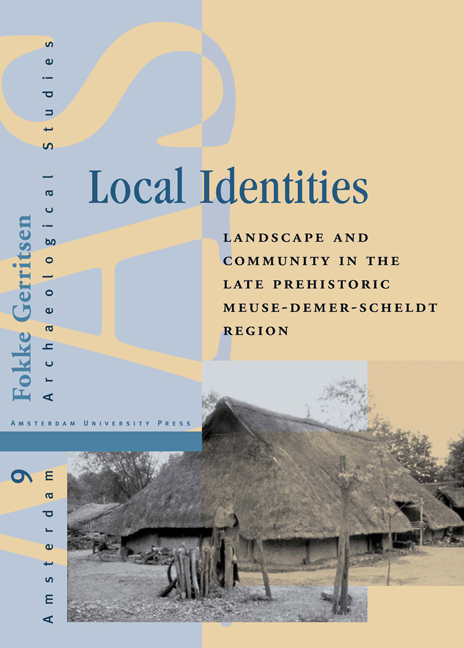Book contents
- Frontmatter
- Contents
- Acknowledgment
- 1 Introduction
- 2 Archaeology in a Sandy ‘Essen’ Landscape
- 3 The House and its Inhabitants
- 4 Local Communities and the Organisation of the Landscape
- 5 Micro-Regional and Regional Patterns of Habitation, Demography and land use
- 6 Landscape, Identity and Community in the First Millennium BC
- Abbreviations
- References
- Appendix 1 Meuse-Demer-Scheldt Region. Distribution of Urnfields
- Appendix 2 Catalogus of Urnfields
- Index of Geographical Names
5 - Micro-Regional and Regional Patterns of Habitation, Demography and land use
Published online by Cambridge University Press: 28 January 2021
- Frontmatter
- Contents
- Acknowledgment
- 1 Introduction
- 2 Archaeology in a Sandy ‘Essen’ Landscape
- 3 The House and its Inhabitants
- 4 Local Communities and the Organisation of the Landscape
- 5 Micro-Regional and Regional Patterns of Habitation, Demography and land use
- 6 Landscape, Identity and Community in the First Millennium BC
- Abbreviations
- References
- Appendix 1 Meuse-Demer-Scheldt Region. Distribution of Urnfields
- Appendix 2 Catalogus of Urnfields
- Index of Geographical Names
Summary
INTRODUCTION
RESEARCH QUESTIONS
Having discussed households and local communities in the previous chapters, in this chapter I will address settlement patterns and subsistence strategies in relation to changing environmental conditions. A related issue for attention concerns long-term demographic trends. My objective is to link the settlement territories that remained rather abstract in the previous chapter to their landscape context, the physical landscape, that is, of soils and topography, and of vegetation, agricultural potential and limitations.
Agricultural systems and environmental change are usually studied in specialised sub-disciplines of archaeology, using soils and botanical and faunal remains as their main sources of information. In contrast, I will address these issues primarily through a study of micro-regional and regional settlement patterns, partly because relevant ecological data are rather scarce for the MDS region, but also because the settlement record provides valuable evidence that has not been systematically integrated with ecological data. In this chapter, an integration of both categories of evidence will take place only to the extent that ecological data are available or can be extrapolated from neighbouring regions, but methodologically the main aim is to investigate the potential of settlement data for studies of subsistence and environmental change.
There is one essential assumption to be made here.This is that there is a spatial relationship between farmsteads and settlements on the one hand and arable lands on the other, and therefore that the locations of farmsteads and settlements are representative of the locations of the fields.This appears a fair assumption for the later prehistoric societies of the Northwest European Plain, in which all or practically all households depended on a mixed subsistence strategy of crop cultivation and animal husbandry, and agricultural potential had a major impact on settlement patterns.The scale of analysis, however, is important. The immediate environment of a farmstead or settlement (if the environment could be reconstructed at such a fine resolution) is not necessarily indicative of the local environment in which the fields are located. But in a perspective that focuses on regional and micro-regional patterns and long-term developments, the coarser resolution means that farmsteads and fields can be combined more confidently.
- Type
- Chapter
- Information
- Local IdentitiesLandscape and Community in the Late Prehistoric Meuse-Demer-Scheldt Region, pp. 199 - 234Publisher: Amsterdam University PressPrint publication year: 2003



